Some photos that didn’t get into the previous posts…
-

-
Richard Lee (Chairman, HNS) opening the conference
-
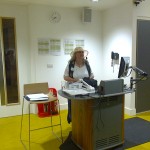
-
Helen Hollick introducing the HNS Indie Novel Award
-
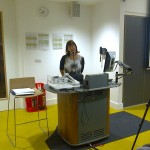
-
Orna Ross of ALLi (judge and sponsor)
-
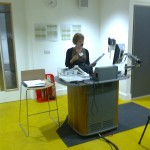
-
Elizabeth Chadwick, judge, announcing the winner)
-

-
Orna Ross, Richard Lee and the winning books
-

-
Watching the announcement
-
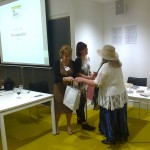
-
Prizes for the judges
-

-
Me with Orna
-
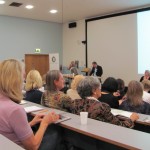
-
Saturday morning audience
-
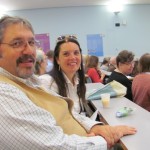
-
Kelvin Woolmer, Jean Fullerton
-
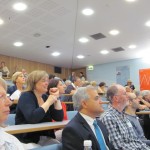
-
Rapt
-
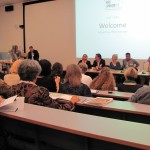
-
Selling historical fiction panel
-

-
Conn Iggulden in full flow
-

-
Conn, pensive
-

-
Jean Fullerton, Bernadine Kennedy, Fenella Miller, Maureen Lee
-

-
Thoughtful Harry Sidebottom, Douglas Jackson, Margaret George
-

-
Hm, Romans
-

-
My era is better than yours
-
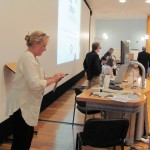
-
Charlie Farrow, organiser, checking something
-

-
Sunday morning
-

-
Mystery and fantasy panel
-

-
Deborah Harkness enthusing
-

-
Richard Lee: Has it finished?
-

-
My room at Marylebone Hall
-

-
London at night
-

-
Moonrise over London
-

-
Sunrise Monday morning
My first HNS conference post
Second HNS conference post
Alison Morton is the author of Roma Nova thrillers, INCEPTIO, and PERFIDITAS. Third in series, SUCCESSIO, is now out.
Find out about Roma Nova news, writing tips and info by signing up for my free monthly email newsletter.
If you enjoyed this post, do share it with your friends!Like this:Like Loading...
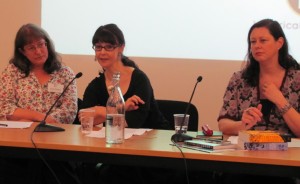 Diana Wallace, Essie Fox, Kate Forsyth Maybe it was adrenaline, but I started the second day of the HNS conference with an energy surge. Maybe the coffee was stronger than I thought. After chatting with friends, I set up the indie table for the day. Managed by the inestimable Helen Hollick, it showcased the finalists’ books for the HNS Indie Novel Award plus a selection of other good quality self-published books and cards from many more. The buzz around the table was fairly constant…
The first session that morning was confronting historical fact with the unexplained, from myths, and the occult to fairytales and the Gothic. Under Kate Forsyth’s able chairmanship, we learnt about ‘historical empathy’ (Deborah Harkness) where fantasy, myth, history and science fiction met. Here were the non-winners in the occult versus natural sciences debate.
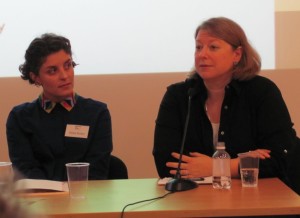 Jessie Burton, Deborah Harkness Jesse Burton (The Miniaturist) took us into magical realism where a cabinet-sized replica of the heroine’s new home brings surrealism and danger. Professor Diana Wallace drew attention to the Gothic novels written by women well before Walter Scott’s Waverley which had been seen as the first historical novel. Perhaps women’s writing was not seen as ‘serious’? Was it still the case? Essie Fox urged us to read the fiction produced at the time we were writing about; it would give us a unique insight into the concerns of that day. The idea of historical truth was not a fixed one…
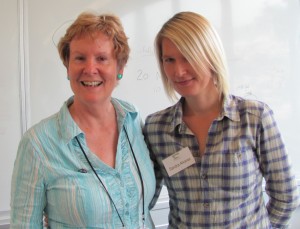 Me with fellow workshop giver Sandra Alvarez After another stint on the indie table, it was my turn to give a workshop on social media, and with Sandra Alvarez of Medievalists.net. Sandra outlined how essential it was for authors to be present on the social network. As a professional blogger, Sandra received hundreds of books to review and was frustrated when an author had no social media links for her readers to progress to after reading the review. Digital signposts were crucial to increase a book’s visibility. She outlined some of the channels such Twitter, Facebook, Google+, website, blogging. Tumbler and Pinterest.
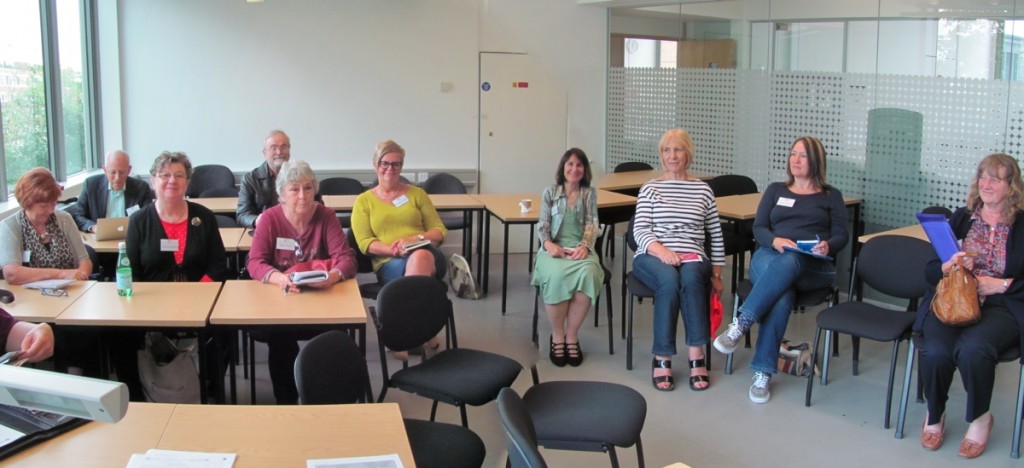 Our lovely social media group (compiled photo) I gave my experience with each from the author point of view, (I’ll do a separate post!), and included the excellent opportunities offered to readers and authors by Goodreads – ‘Facebook for books’. Giveaways, author programme, segmenting, book groups and the ease of re-posting your blogs, videos and, of course, your books! Amazon author pages on at least the UK and US sites were essential and very easy to add text, photos and videos, and edit. But the push behind all this was publicising yourself: selling yourself as a brand as a precursor to selling your books. Questions from a lively and thoughtful audience about websites, blogging, FB personal profile v. page, time to spend on social media, rounded our session off.
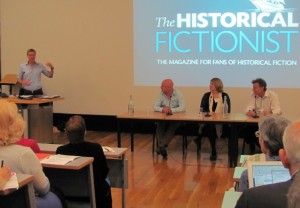 Jon Watt, Anthony Riches, James Heneage, Cathy Rentzenbrink The fun quiz of audience v. Roman author Anthony Riches, Ottaker’s founder James Heneage and The Bookseller’s Cathy Rentzenbrink, compered by Jon Watt of the Historical Fictionalist, tested our knowledge of when some popular historical fiction was set. I was slightly disconcerted when not a few of the audience plumped for 1st century AD for G.Julius Caesar’s assassination, but on the whole, we guessed accurately.
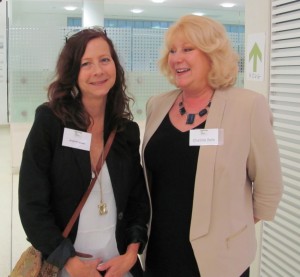 Novelists Henri Gyland, Charlotte Betts Sadly, that was the last session of the conference, but over a sandwich lunch and back at the indie table, I talked myself hoarse about all things books and was still meeting friends even at this stage. The organisers Richard Lee, Charlie Farrow and team have my warmest congratulations for an excellent event which gave us fun, knowledge and buzz.
Next year it’s in Denver. Mm, is a trip to the US on the cards?
Read about the previous day…
‘Bonus’ photos
Alison Morton is the author of Roma Nova thrillers, INCEPTIO, and PERFIDITAS. Third in series, SUCCESSIO, is now out.
Find out about Roma Nova news, writing tips and info by signing up for my free monthly email newsletter.
If you enjoyed this post, do share it with your friends!Like this:Like Loading...
 Hot, tired and stressed out after flight delay and snail-slow taxi ride from Liverpool Street Station, I arrived at Marylebone Hall, the accommodation block at the University of Westminster, fit to drop. I flung on a clean shirt, combed my hair and abandoning unpacking, I hurried down to the lobby. The sound of chatter and clinking glass and broad smiles of people who had spotted me instantly dispelled the weariness and frustration. Here were friends, here were book people; readers, writers, agents, publishers, colleagues. Hot, tired and stressed out after flight delay and snail-slow taxi ride from Liverpool Street Station, I arrived at Marylebone Hall, the accommodation block at the University of Westminster, fit to drop. I flung on a clean shirt, combed my hair and abandoning unpacking, I hurried down to the lobby. The sound of chatter and clinking glass and broad smiles of people who had spotted me instantly dispelled the weariness and frustration. Here were friends, here were book people; readers, writers, agents, publishers, colleagues.
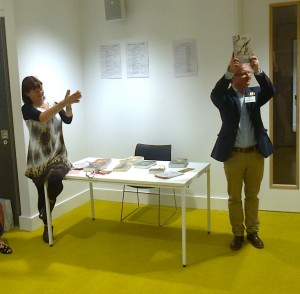 Orna Ross (ALLi) and Richard Lee (HNS) It was a good twenty minutes before I reached the wine table – possibly a record for me. Glass in hand, I listened to Orna Ross of the Alliance of Independent Authors (ALLi), shortlist judge, and Elizabeth Chadwick, final judge, announce the HNS Indie Award prizewinner The Subtlest Soul by Virginia Cox. Prizes were donated by donated by Orna Ross, and Geri Clouston of Indie B.R.A.G.
Greetings, chats, faces I knew, introductions to those I didn’t know all passed in a blur and ended at Hardy’s Brasserie a little later with a delicious meal of smoked mackerel, steak and ale pie and chocolate and orange cake with vanilla ice cream, all washed down with (more) wine.
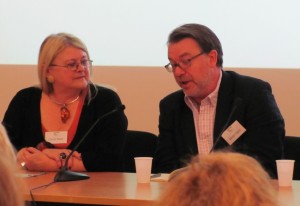 Carole Blake and Simon Taylor Saturday morning, coffee and Danish later, we started with a welcome by HNS chair, Richard Lee, then straight into the first panel. Agent Carole Blake chaired ‘Selling historical fiction’ with Matt Bates from W H Smith, Katie Bond of Bloomsbury, Nick Sayers (Hodder & Stoughton) Simon Taylor of Transworld and Susan Watt from Heron Publishing. Usual things: a cracking good story, great cover, well-edited. The strongest trend was still Tudors, with all other periods well behind.
 Conn Iggulden Next up was Conn Iggulden, the best selling Roman author, who gave a stellar performance, telling self-deprecating stories with a comedic edge about his writing career. We were captivated. The two things about writing historical fiction I took away were: fill in gaps intelligently, and fiction benefits from history and history benefits from fiction.
For me, the Roman theme continued. ‘Veni, vidi vici’ workshop with Douglas Jackson, Harry Sidebottom and Margaret George discussed our continual fascination with the Romans.
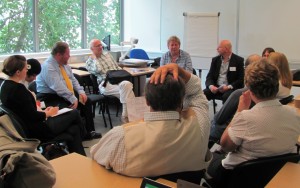 Why Romans? The length of the civilisation, its richness of archaeology and sources, its organised, dominant state and military machines and, as Margaret George noted, all those films that Hollywood and TV has produced were possible reasons. I was in my element and contributed enthusiastically!
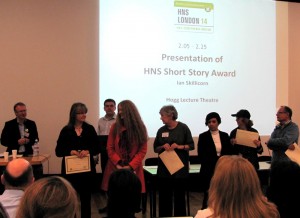 Lorna (at left) looking shell-shocked!
The HNS Conference Short Story Award (open to all HNS members attending the conference) came after a sandwich lunch and I was delighted that fellow ALLi member Lorna Fergusson won!

A slightly recovered Lorna sharing the good feeling with me and fellow indie author Anna Belfrage.
Then came a highly entertaining session called ‘My era is better than yours’ with Philip Stevens keeping order, and panellists Angus Donald (Medieval), Suzannah Dunn (Tudor), Antonia Hodgson (Georgian), Giles Christian (Viking and Civil War) and Harry Sidebottom (Ancient Rome).
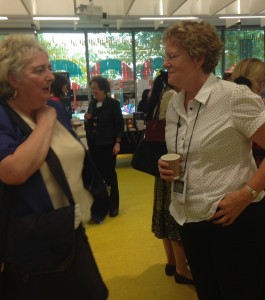
During the tea break, I chatted with my heroine, Lindsey Davis, the author of the Falco mysteries set in 1st century AD Rome. I managed this time not to be fazed by her greatness and she was charming (Photos courtesy of Dave and Ann McCall).
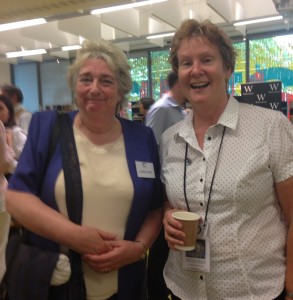 Lindsey Davis Lindsey was a good sport to talk to a relatively new kid on the Roman writing block. Of course, I went to her interview with Jerome de Groot.
Then it was back to Hardy’s that evening for London Particular (pea and bacon soup), kedgeree, and pear and ginger crumble with custard. Yumm!
Read what happened the next day…
‘Bonus’ photos
Alison Morton is the author of Roma Nova thrillers, INCEPTIO, and PERFIDITAS. Third in series, SUCCESSIO, is now out.
Find out about Roma Nova news, writing tips and info by signing up for my free monthly email newsletter.
If you enjoyed this post, do share it with your friends!Like this:Like Loading...
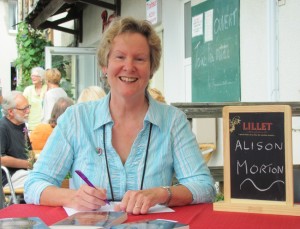 Last weekend, I spent two lovely days at a local literary festival at the village of Saint-Clémentin in the Deux-Sèvres. Guests included Michèle Roberts, Leigh Russell and Blake Morrison, plus a number of local writers and poets. Last weekend, I spent two lovely days at a local literary festival at the village of Saint-Clémentin in the Deux-Sèvres. Guests included Michèle Roberts, Leigh Russell and Blake Morrison, plus a number of local writers and poets.
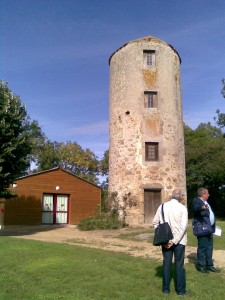 Walking with poetry – the mill
There were walks with poetry, writing projects with local schools, participative poetry readings, interviews, workshops, local crafts and gastronomy and a wonderful bookshop.
Local authors like me were encouraged to sell and sign their books. And the sun shone.
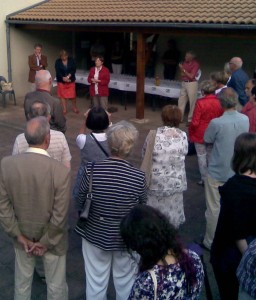 Welcome from Madame le maire Given that Saint-Clémentin has only just over 1,000 inhabitants, staging a three day littlest with over 50 authors and as many events was miraculous.
But the local writers’ group and an army of volunteers are to be congratulated. It only took two years of planning, the organisation of a military operation and energy resources of a new galaxy to do it.
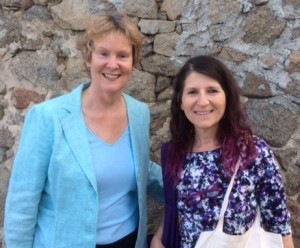 With Leigh Russell
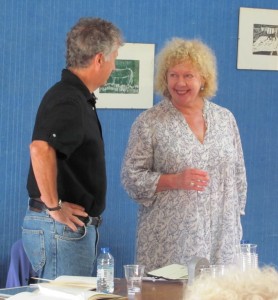 Blake Morrison and Michèle Roberts
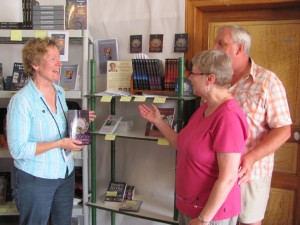 With Cathy and Jon Welch who ran the bookshop
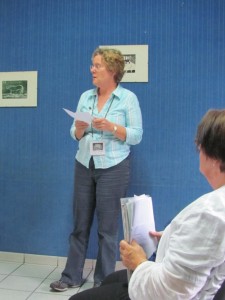 Reading a poem
 Saint-Clémentin
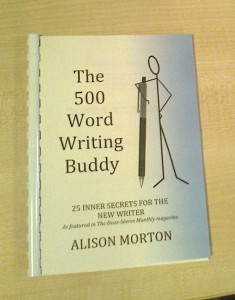 And I sold a lot of these!
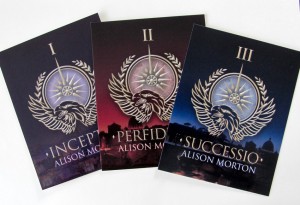 And some of these!
Alison Morton is the author of Roma Nova thrillers, INCEPTIO, and PERFIDITAS. Third in series, SUCCESSIO, is now out.
Find out about Roma Nova news, writing tips and info by signing up for my free monthly email newsletter.
If you enjoyed this post, do share it with your friends!Like this:Like Loading...
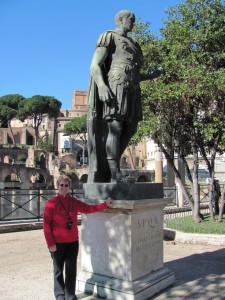 Me and G.J.Caesar An awful lot!
This is only a brief introduction, but hold on tight because this may seem a little confusing…
Even in the earliest times, Romans used a different system of names from most other European and Mediterranean countries. They used two names, one of which became a hereditary surname. Over time, this expanded to include additional names and even nicknames.
Basics
The most familiar version of the Roman name is the tria nomina, or “three names” – praenomen, nomen, and cognomen – used by male Roman citizens for over a thousand years. Gaius Julius Caesar is a good example.
What means what?
A praenomen (plural praenomina) was a personal name, often following family or tribal tradition, e.g Marcus, Gaius, Aulus, Quintus, and used mostly within the family and close friends. but outside of this circle, they might be called by their nomen, cognomen, or any combination of praenomen, nomen, and cognomen that was sufficient to distinguish them from other men with similar names.
The nomen (plural nomina) designated a Roman citizen as a member of a gens – a ‘race’, ‘family’, or ‘clan’ – which constituted an extended Roman family claiming descent from a common ancestor, e.g Julius, Flavius, Claudius, Cornelius.
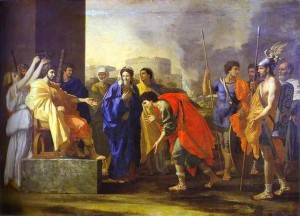 The Continence of Scipio (Nicholas Poussin 1594 -1665) The cognomen began as an additional personal name but the gradual decline of the praenomen as a useful means of distinguishing between individuals made the cognomen a useful means of identifying both individuals and whole branches of Rome’s leading families. Additional cognomina were added if a person was adopted into another (often socially superior) family; in his will, the dictator Gaius Julius Caesar adopted his great-nephew, Gaius Octavius, who became known as Gaius Julius Caesar Octavianus. Sometimes an agnomen (similar to cognomen) was added as a result of a heroic act, e.g. Publius Cornelius Scipio Africanus, who took the Second Punic War to Africa, and defeated Hannibal.
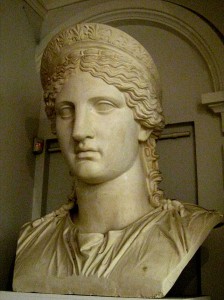 Antonia Minor, Mark Anthony’s daughter, mother of emperor Claudius Roman women’s names
In the earliest period, Roman women shared the same name format as men, praenomen and nomen. By the end of the Republic, the majority of Roman women did not use praenomina. Most women were called by the nomen alone, in the feminine form, e.g. Cornelia, Claudia or Julia.
For men, who might hold public office or serve in the military, the praenomen remained an important part of the legal name, and a way of distinguishing them from other members of their family who might also be serving. But although they sometimes exerted significant influence behind the scenes, Roman women played practically zero role in public life, so were not thought to need an individual name.
Moreover, a praenomen was not usually seen as necessary to distinguish between women within the family. If there were multiple sisters in the same household then a cognomen or a combination of nomen and cognomen was used, e.g. Julia Tertia (third) or Volusenia Minor (younger). Roman women did not change their original (father’s) nomen when they married, so a new daughter in law’s nomen alone was usually sufficient to distinguish her from every other member of the (new) family. This blatant lack of individualisation seems alien to us today when our first or given name is extremely important to our sense of ourselves.
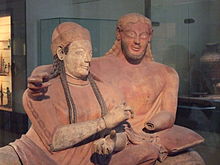 Etruscan couple (tomb sculpture) Although women’s praenomina were infrequently used in the later Republic, they did continue into imperial times, especially among the other peoples of Italy, until the populace was thoroughly Romanized. In the Etruscan culture, for example, where women enjoyed a markedly higher social status than in Rome, inscriptions referring to women nearly always include praenomina. (Read Elisabeth Storrs’ excellent The Wedding Shroud)
 Caracalla Changing times
When Caracalla turned all free inhabitants of the Roman Empire into full-blown citizens in AD 212 (mainly to be able to tax them), new citizens adopted the nomen ‘Aurelius’ in recognition of the emperor’s ‘gift’ (his proper name was Marcus Aurelius Severus Antoninus Augustus, with Aurelius as the nomen). ‘Aurelius’ quickly became the default nomen in the east and the second most common after ‘Julius’ in the west.
Caracalla’s ‘New Romans’ and even many established Romans either dropped the nomen from their name or, in some cases, treated the nomen as a praenomen. Although a nomen would long be required for official purposes, and in isolated corners of the empire and in parts of Italy, its everyday use would continue into the 7th century, the nomen was generally omitted from the name by the close of the 3rd century.
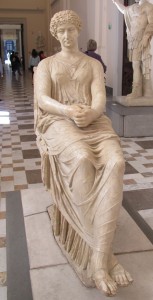 Flavia Iulia Helena Augusta, known as Helena of Constantinople or St.Helena With the infusion of Greek culture into the Roman Empire, the use of patronymics (‘son of’) and by-names such as ‘the wise’ or ‘the short’, and descriptive, such as ‘of Antioch’ or ‘the tailor’, began to displace inherited surnames; the Greeks did not have such a keenly developed sense of genealogy as the Romans did. Family names are completely missing or rare in documents and seals dated from between the 7th and 10th centuries. Eventually, family names were seen as a quaint custom.
Later, Roman women, like men, adopted signa, or alternative names, in place of their Roman names. With the fall of the Western Empire in the 5th century, the last traces of the distinctive Italic nomenclature system began to disappear, and women, like men, reverted to being known by single names.
And Roma Nova? The Twelve Families’ members kept their nomina (of which they were very proud) and developed the custom of adding a personal name or praenomen to give each family member an individual name; they were only a few hundred at the beginning, and each individual was needed, and valued, for the colony to survive. Over the centuries, other Europeans added surnames, developed from occupation, locality or nicknames, to their personal names; these often chopped and changed, becoming extinct or hyphenated. Roma Novans adopted descent and inheritance through the female line and retained a family/tribal system of sharing a nomen with all members of their family. Their most treasured possessions included their family records, whether on parchment, paper or digital.
And so our heroine’s name has followed Roma Novan tradition: her personal name is Carina and her family name Mitela – the nomen used in the fourth century AD by her far-off ancestor, Gaius Mitelus.
Alison Morton is the author of Roma Nova thrillers, INCEPTIO, and PERFIDITAS. Third in series, SUCCESSIO, is now out.
Find out about Roma Nova news, writing tips and info by signing up for my free monthly email newsletter.
If you enjoyed this post, do share it with your friends!Like this:Like Loading...
|
Subscribe to Blog via Email
Join 50 other subscribers.
Categories
Archive
|




































































